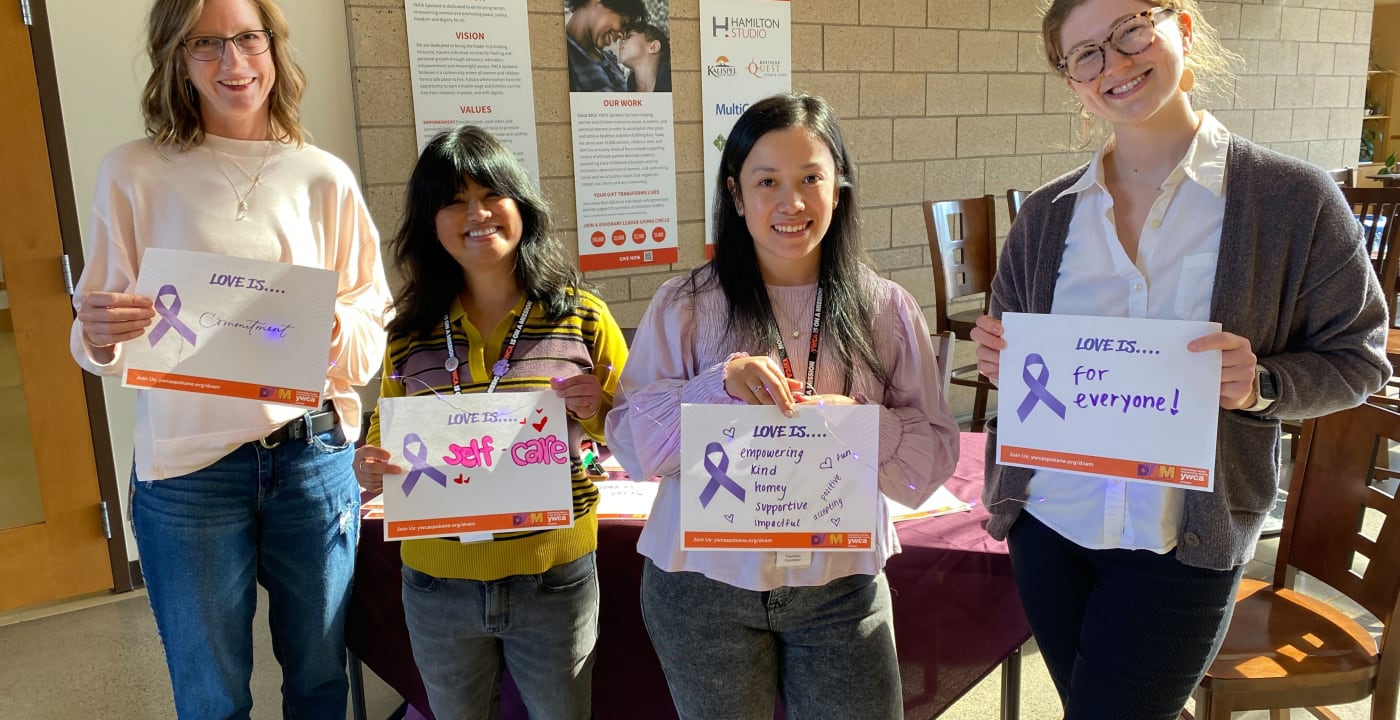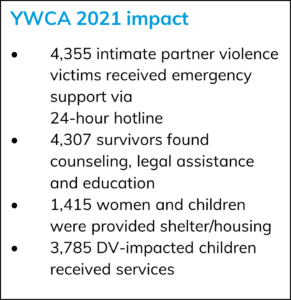‘This isn’t hopeless’: SRDVC and YWCA highlight power of community, prevention against domestic violence

No matter how many times we hear it, it’s alarming — Spokane County has the highest rate of domestic violence incidents in Washington state. And the numbers continue to rise, with a 40 percent increase in DV calls to law enforcement in 2020.
Domestic violence not only takes a toll on the physical and emotional well-being of an individual, both now and in the future, but can also have serious impacts on family and pet safety, housing, financial stability and career/workplace performance, among others.
The Spokane Regional Domestic Violence Coalition (SRDVC) is on a mission to reduce domestic violence incidents in the Inland Northwest by partnering with community members like MultiCare Health System, as well as agencies, schools, law enforcement and governmental entities through:
- Education and awareness
- Connection to resources
- Improving conditions after the crisis
Spreading awareness
SRDVC works toward these goals through various campaigns, including their biggest so far, “End the Violence,” which featured the story of DV survivor Nichole in a documentary.
Another campaign, Purple for a Purpose, brought together numerous local organizations and businesses to raise money for prevention programs through purple-themed offers and events. Visit the 2022 campaign to learn more.
The SRDVC also aims to shine a light on a specific group of at-risk individuals — missing and murdered indigenous women. In partnership with regional tribal organizations, SRDVC helped launch a billboard campaign in 2021 to bring awareness to the state’s crisis. According to the Washington State Patrol, as of Oct. 3, 2022, there were 132 Native American persons missing in Washington state — a number believed to be greatly underreported.
Taffy Hunter, SRDVC education and outreach coordinator, says they’re also working to launch a business toolkit, which provides local business leaders with information, access to trainings and other education to help recognize domestic violence in the workplace.
Educating youth
Hunter says many domestic violence survivors not only have their own intimate partnership story, but also childhood experiences of violence in the home. Perpetrators have often experienced childhood traumas, too.
“The things we experience early on in life have lasting impacts,” she says. “There are so many stories of young people in our community who witness domestic violence at home or are child abuse victims. We’re focused on intervening with those young people sooner.”
The SRDVC partners with local law enforcement, school districts and the Spokane Regional Health District to provide support to children at the scene of domestic violence incidents. School counselors are notified when a child has experienced such an incident so they can provide confidential intervention and support such as food, clothing, rest and someone to talk to.
By educating and empowering youth during traumatic moments, it is the SRDVC’s hope to prevent cycles of abuse.
Post-incident support
Teaming up with YWCA Spokane, a nonprofit agency that provides support to victims of intimate partner violence, the two organizations were awarded a $550,000 Justice for Families grant in 2021 to create a domestic violence court in Spokane. This specialized court provides trauma-informed support to victims and equips judges and personnel with tools to understand the complex dynamics of domestic violence and therapeutic, whole-family approaches to treatment.
Post-crisis support for DV survivors and families is where SRDVC most leans into their community partners — a longtime one being the YWCA.
YWCA brings support, services and calls for action
Erica Schreiber, YWCA director of community engagement, says their goal is to provide a safe place for all.
“Our long-term goal is to empower survivors, families and communities through a combination of DV prevention and response work, disrupting long-standing patterns of trauma by working at the intersections of inequality, poverty and DV,” she says.
YWCA has been operating since 1903 to provide domestic violence survivors with safety planning, advocacy, therapy, education and prevention work, shelter, housing, legal services, and healing support such as trauma-informed yoga classes. They also provide economic advancement support through skill-building and financial education, employment support and clothing resources. And just as SRDVC is focused on preventing domestic violence from a young age, the YWCA has a range of youth services, including education on healthy relationships and access to trauma support.
Over the past 10 years, Schreiber says the YWCA has served an average of 15,000 people impacted by domestic violence, homelessness and unemployment annually.

Misconceptions challenge support and prevention
Despite the number of people utilizing YWCA’s services, Schreiber says this is such a complex topic that many people in our community aren’t aware of its prevalence.
“Awareness about DV is growing. In a recent community needs assessment, DV was identified as a top concern,” she says. “However, [it] is incredibly complex and many individuals who are involved in an abusive relationship do not identify as such.”
From misconceptions about what an abusive relationship is and isn’t to myths about how to support a survivor, Schreiber says many survivors are made to feel they are the problem and don’t reach out for help. Read more about domestic violence misconceptions in our article Domestic Violence Action Month: Learn the warning signs and support victims with compassion.
Schreiber says domestic violence continues to be a hidden epidemic and is a community issue that requires a collective response to create change.
Changing our mindset
“So, why do we keep talking about it?” asks SRDVC’s Hunter.
Talking about domestic violence will allow the community to break down the shame and guilt surrounding it — and better examine why people perpetrate and prevent abuse, she says.
Hunter is excited for the next phase of the Inland Northwest’s approach to preventing DV: taking action to fix it.
“The first step to prevention is to think I can [make a change],” she says. “This isn’t hopeless.”
The SRDVC plans to utilize the “power of the positive” moving forward.
“The [Montana Summer Institute] has a lot of research that proves that to change society’s behavior, the scare tactics we are used to seeing and using really don’t work,” Hunter says.
Instead, SRDVC wants to share positive community norms the region has developed, she says. For example, people may think no one is using the YWCA’s domestic violence resources, but a community survey may show otherwise.
It’s Hunter’s hope that by showing the positive community norms already in place, the SRDVC may be able to illustrate there is hope — that our actions are working and there’s measurable value in having these conversations. As they begin developing surveys, she asks that anyone willing and able — all neighborhoods and backgrounds welcome — to participate.
Domestic violence is preventable, she says, and with October being Domestic Violence Action Month, it’s a great opportunity get involved in being part of the solution.
“Partnering for healing and a healthy future” is MultiCare’s mission, and it inspires us to form connections that help improve the quality of life for our communities. Community organizations all around us are doing amazing work, and we’re inspired and excited to support that work.
Stories from our Community is an ongoing series conceived to dive into some of these organizations*, bring their stories to life and spread the word about how they are making our communities better.
*Some of the organizations profiled in this series are recipients of MultiCare’s Community Partnership Fund, which awards funds to nonprofit organizations working on initiatives, programs and projects that improve our community.




